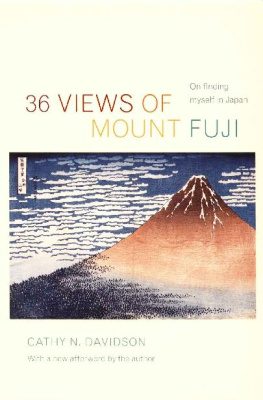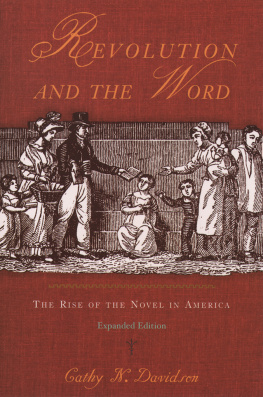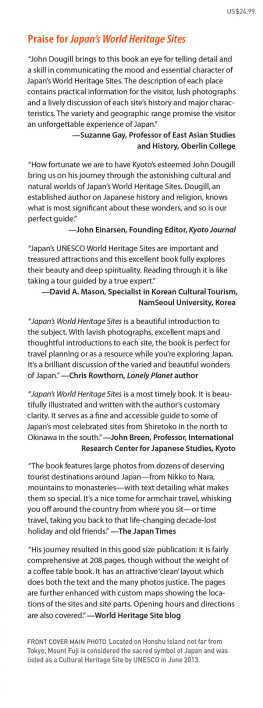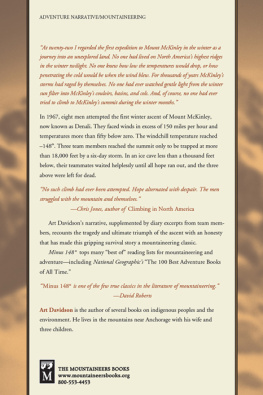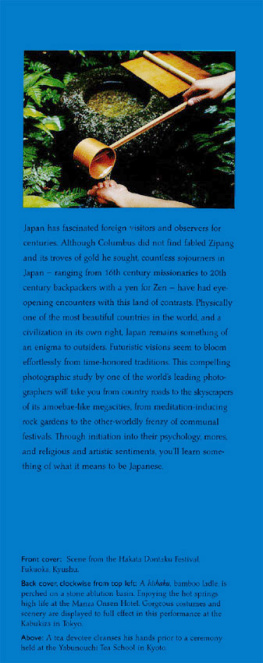PRAISE FOR CATHY N. DAVIDSONS
36 VIEWS OF MOUNT FUJI
AppealingNo one could have tried harder to fathom Japanese culture [than Davidson]. The result is a series of illuminations not unlike the sudden break in the clouds that finally lets her glimpse Mount Fuji from the window of a bullet train.Francine Prose, New York Times Book Review
Intelligent, sympatheticand quick-witted.Elizabeth Ward, Washington Post Book World
Davidson is a droll guide and a questing soul. Her observations of Japanese women, and of the nighttime Floating World of barsare particularly sympathetic and astute. In traveling halfway around the world, Davidson discovers how to abide with herself.Elle
Beautifully written 36 Views of Mount Fuji resonates like one of the Japanese temple bells Davidson so hauntingly describes: profound, clear, and unforgettable. I did not want to putitdown.Susan Allen Toth, author of Blooming: A Small-Town Girlhood
Luminous Nuanced and passionate, [Davidsons] book achieves what many travel writers can only aspire to: the sense of being both inside and outside of a culture at the same time and the profound feeling that this journey has indeed led her to someplace she has always wanted to go.Booklist
Empathy infuses Davidsons reactions to the Japanese and lifts this graceful, balanced account of her experiences in their country above the ordinary. Her charmingly drawn word-pictures resonate.Publishers Weekly
A delightful read, offering insight not only into Japan but into the adventure of living in a foreign culture anywhere in the world.Mary Catherine Bateson, author of Composing a Life
Brilliant, wise, and wittyas enjoyable a read as Peter Mayles A Year in Provence. Any Westerner who thinks they understand, or wants to understand, the contrasts between Japanese culture and our own, or who thinks that its virtues can be transplanted to another culture, must read this book.Louise DeSalvo, author of Virginia Woolf
Davidson is uniquely equipped for this journey, armed with intelligence, warmth, and a feminist consciousness that makes her seek out, in Japan, the hidden women as well as the more evident men.E. M. Broner, author of A Weave of Women
Alovely book. It offers both the most balanced view of Japan I have encountered and a gripping personal journey. Strong and delicate, it resembles the Japanese people Cathy Davidson describes.Marilyn French, author of The Womens Room
Davidson is a sensitive observer, finely attuned to the behavioral nuances that define a culture. And she is equally perceptive of her own responses to Japan.Atlanta Journal-Constitution
Perceptive, frank, and personalone of the best explanations of Japanese culture, and our problems in understanding it, that has come along in years.Library Journal
SuperbA jewel 36 Views of Mount Fuji is several books in one, and each one is a delight. Davidson writes in the higher tradition of elegant memoirsgracefully, thoughtfully, humorously.Trenton Times
This book is honest and even-handed, respecting the complexity of the mystery that is Japan. It is a book that should be read by anyone serious about learning more of this fascinating country.Lincoln Journal-Star
DelightfulReads like a wonderful, intimate letter from a friend. Davidsons book is brimming with understated emotion and insightfully plumbs the spiritual dimensions of both cultures.Virginian-Pilot and Ledger-Star
Top drawergrows like a novel and takes on unusual richness as it keeps reinvesting itself in earlier scenes and people.Kirkus Reviews
Parts of this very personal American teachers Japanese memoir, like the delicate chapter about her Nigawa neighbors reactions to a Christmas season death in her husbands family, had us crying. Trust us. Try it.New York Daily News
Beautifully written 36 Views of Mount Fuji is not a travel book in the usual sense. It is a book about a much deeper process, the way in which another culture can infiltrate us and make us different people. It opened my eyes to the beauty of another culture and also made me appreciate aspects of my own.Raleigh News and Observer
EvocativeA revealing mosaic of word-pictures of Japan and the Japanese. Here are cameos of friends and acquaintances, a wealth of experiences, some funny, some tragic, all revealing, moments that interpret and explain, or surprise and bewilder.Anniston Star
36 VIEWS OF MOUNT FUJI
36 VIEWS OF MOUNT FUJI
On Finding Myself in Japan
CATHY N. DAVIDSON
With a new afterword by the author
Duke University PressDurham and London2006
2006 Duke University Press
All rights reserved.
Printed in the United States of America on acid-free paper
Designed by Heather Hensley
Typeset in Bembo by Tseng Information Systems, Inc.
Author royalties from the sale of this edition of 36 Views of Mount Fuji have been donated to the Duke University Press Fund for the Publication of Authors First Books.
Original edition published by E. P. Dutton, 1993.
Library of Congress Cataloging-in-Publication Data appear on the last printed page of this book.
CONTENTS
For Ichir, Naomo, and
Maryvonne Nagel Okamoto,
tomodachi,
and for the Japanese friends
who, though pseudonymous
here, inspired every page
A NOTE ON JAPANESE NAMES
In Japan, the genderless suffix -san is appended to names as token of respect. It is roughly the equivalent of Mr., Ms., Mrs.,or Miss. Many of my Japanese friends compromise between formal Japanese address and the informality of English by calling me Cathy-san, and I call a number of my friends by their first names, Kiyomi-san or Tomoe-san. Some Japanese who have spent time in the West drop the -san suffix entirely. I have rendered these levels of formality (and Westernization) in this book situationally, mainly according to the terms I would have used in Japan. Also, I have given the family name last here (although in Japan it would go first).
In my phonetic transcription of Japanese words and phrases (rmaji), I have used a macron to indicate long vowel sounds except in the case of a long i (which is indicated by a repeated letter, as in hazukashii). I have also followed the usual practice in English-language publications of omitting the macron in common Japanese place names such as Osaka or Kyoto.
A Glossary of Japanese Words and Expressions can be found at the back of this book.
LIST OF ILLUSTRATIONS
All illustrations come from Katsushika Hokusais Thirty-Six Views of Mount Fuji. Courtesy of the Honolulu Academy of Arts.
PREFACE
The title of my book, Thirty-Six Views of Mount Fuji, comes from the series of woodblock prints done by Katsushika Hokusai (17601849) near the end of his long life. In these brilliantly colored prints, as well as in a blackand-white sequel that he called One Hundred Views of Mount Fuji, Hokusai portrays the different, even contradictory, aspects of Japanese life. There is tremendous variety and vitality in both seriesaristocratic courtiers, humble workers, carefree picnickers, devout pilgrims. The only constant is Mount Fuji, symbol of that which is permanent or unchanging in Japan. Hokusai does nothing to reconcile contradictions, but the presence of the mountain suggests that all of the views, taken together, make up Japan. In one woodcut, a weary traveler pauses for refreshment, and is surprised to find Fuji reflected in his tiny sake cup. In another, boatmen row madly to escape a fearful storm, too concerned with survival to notice Fiji, calm in its indifference, beautifully framed within the curl of a towering wave.

